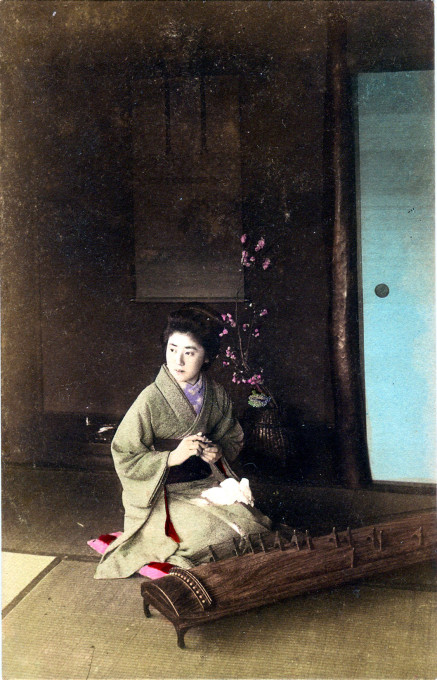“While much of the repertoire of the biwa and shakuhachi is a product of the Edo period, it is the music of the koto and shamisen that best represents this very musical era. The shamisen belongs to the world of the theater and all the turbulent excitement that the entertainment districts of Edo represent. The koto, by contrast, developed out of the court tradition and gradually entered the home as an accomplishment for the daughters of the rising commercial class as well as those of the nobility.
“The koto‘s harp-like tone added a gentler hue to the generally gaudy picture of Japan from the seventeenth through the nineteenth centuries. This quality helped koto music survive during Japan’s Westernization. It met the approval of Victorian taste and did not suffer from the unsavory past or un-Western sound of the shamisen.
“… Finding beautiful ladies by means of their koto music seemed to be a favorite among many Japanese writers. In the biwa saga, The Tale of the Heike, a trusted vassal is sent to find the emperor’s recently lost paramour. Her hiding place is unknown but her koto playing is so beautiful that the man has only to ride through a likely district until he hears her play. The system works, and the girl, Kogo, is returned to the emperor.”
– Traditional Japanese Music and Musical Instruments, Volume 1, William P. Malm, 2000
The Koto, c. 1910.
1910s • Geisha/Maiko/Onnanoko
Tagged with: Ikebana, Koto, Music, Musicians, Stringed instruments
Please support this site. Consider clicking an ad from time to time. Thank you!



Pingback: Shichirigahama Beach, Koyurugimisaki, & Enoshima, c. 1910. | Old Tokyo
Pingback: Shichirigahama Beach, Koyurugimisaki, & Enoshima, c. 1910. | Old TokyoOld Tokyo